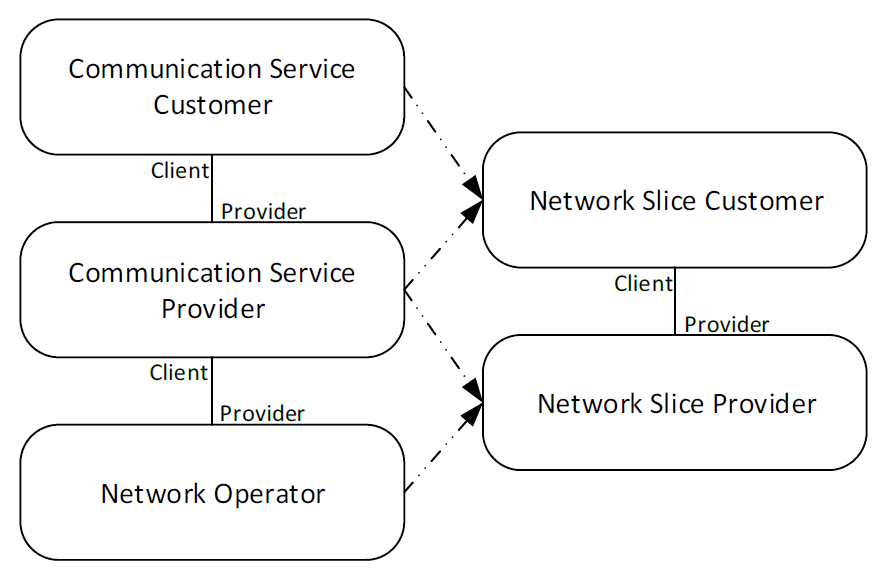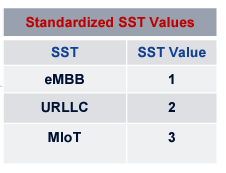Definition
Network slicing is a concept for running multiple logical customized networks on a shared common infrastructure complying with the agreed Service Level Agreement (SLA) for different vertical industry customers and requested functionalities.
To achieve this goal, network slicing needs E2E Network Slicing Architecture to be designed from an E2E perspective, spanning over different technical domains (e.g., device, access network, core network, transport network, and network management system) and multiple vendors.
An End-to-End (E2E) Network Slice consists of RAN, Transport, and Core network slice subnets, with each of these subnets, possibly consisting of further subnets, for example, RAN subnet decomposed further into fronthaul, mid-haul, and RAN Network Functions.
Network Slicing in 5G Network
Network Slicing is one of the key features of 5G. The essence of Network Slicing is to be able to effectively cater to a diverse set of use case categories and customers in an optimal manner.
5G is expected to fulfill the requirements of a wide variety of use cases including urban mobile broadband, massive machine-type communications, and ultra-reliable low latency communications. As it is based on the premise that everything, not just smartphones, will be connected to the 5G Network. 5G networks need to meet a variety of different requirements such as high speed, high capacity, high reliability, and low latency. The function to meet these demands is Network Slicing.

Network Slicing in 5G Vs. 4G
Further, 5G should be able to meet the QoS and quality of experience of different consumers, and industry verticals including connected home, autonomous vehicles, smart cities, remote healthcare, in-stadium experience, rural broadband, factory automation, and smart enterprises. Each of these categories has a different set of performance requirements (e.g., latency, throughput, reliability, availability, etc.) and characteristics (e.g., mobility, security, resource sharing level, etc.).
End-to-end Network Slicing enables addressing these in an optimal manner through sharing of resources and shaping the network dynamically to meet the demands of various services. This, in turn, saves significant CAPEX and OPEX for the communication service provider. Further slice orchestration functionality is another enabler for network automation and shall play an important role in quick service rollouts, as well as service assurance and SLA adherence, leading to an improved end-user experience.
Motivations for Operators to introduce Network Slicing
For operators, there are several motivations to introduce network slicing which is able to be deployed with 5G network.
- Network slicing is a promising feature to permit business customers to acquire connectivity tailored to their specific business requirements by using a common infrastructure. For example, some need high throughput, but others need massive connectivity, or low latency, or high reliability, and so on.
- Network Slicing is one of the key features of 5G. The essence of Network Slicing is to be able to effectively cater to of a diverse set of use case categories and customers in an optimal manner.
- Network slicing deployment using virtualized NFs will benefit from network automation. Network slice customer will be able to order a creation of network slice via APIs provided by network slice provider and this will bring cost advantage on deployment and operation for operators due to reduction of workload.
Roles in network slicing
Multiple roles related to network slicing are displayed in the below figure and specified in 3GPP TS 28.530 as below:

Roles in network slicing
- Communication Service Customer (CSC): Uses communication services, e.g. end-user, tenant, vertical.
- Communication Service Provider (CSP): Provides communication services. Designs build and operate its communication services. The CSP-provided communication service can be built with or without a network slice.
- Network Operator (NOP): Provides network services. Designs build and operate its networks to offer such services.
- Network Slice Customer (NSC): The Communication Service Provider (CSP) or Communication Service Customer (CSC) who uses Network Slice as a Service.
- Network Slice Provider (NSP): The Communication Service Provider (CSP) or Network Operator (NOP) who provides Network Slice as a Service.
Important definitions & Consideration in Network Slicing
- Network Slice
- A logical network that provides specific network capabilities and network characteristics.
- Network Slice instance
- A set of NF instances and the required resources (e.g. compute, storage, and networking resources) form a deployed Network.
- A NS instance spans across the 5GC, 5G-RAN, and the UE.
Considerations in Network Slice Deployment
- Network slices may differ for supported features and network functions optimizations.
- Network slices may offer the same service, but for different sets of users.
Need for Network Slices in 5GS
- Very wide set of use cases/services that require different/incompatible network characteristics.
- Early realization during Rel-15 –a single network cannot meet all these requirements.
Slice Identity Management
Individual slices are formed by an identifier called S-NSSAI (Single-Network Slice Selection Assistance Information).
S-NSSAI is an identifier required to achieve end-to-end network slicing. It is an identifier that allows you to carry around S-NSSAI on terminals (UE), RAN, and Core Network to identify a specific network slice. It was stipulated by 3GPP, an international standardization body.
eMBB (high speed / large capacity), mIoT (multi-connection, power saving, low cost), URLLC (low latency, high reliability) are defined as service types (SST: Slice and Service Type).
- Identifies a Network Slice across the 5GC, 5G-RAN, and the UE.
- Composed of
- Mandatory SST (Slice/Service Type) – 8 bits.
- Optional SD (Slice Differentiator) – differentiates slices with the same SST – 24 bits.

- Standardized S-NSSAI has only SST and no SD.
- Non-Standard S-NSSAI can be defined as either SST alone (Non-standard) or SST + SD.
NSSAI is a collection of S-NSSAIs
Types of NSSAIs
- Subscribed S-NSSAIs
- Stored in the UDM -> 5GC uses this as a default when the UE doesn’t send a Requested NSSAI.
- Configured NSSAI
- The PLMN may configure a UE with 1 or more configured NSSAIs –UE uses this as its default NSSAI
- Could be the same as the Subscribed S-NSSAIs.
- Allowed NSSAI
- The value assigned by the 5GC & valid in a Registration Area or the PLMN over a given access type.
- Requested NSSAI
- Can be either Configured or Allowed NSSAI or a combination of them
- Rejected NSSAI
-
- Can be rejected in the Registration Area (or) for the entire PLMN.
- UE shouldn’t attempt this NSSAI again in that RA or in the PLMN.
-
References:
- GSMA, An Introduction to Network Slicing.
- ONAP, E2E Network Slicing Technical Overview.
- RCR Wireless News, Network slicing 101: 4G versus 5G.












